Best acoustic electric guitars 2025: electro-acoustic picks for every guitarist, whatever your budget
Stand and be heard – embrace the creative opportunities an acoustic electric guitar presents, whether live on stage or in the studio
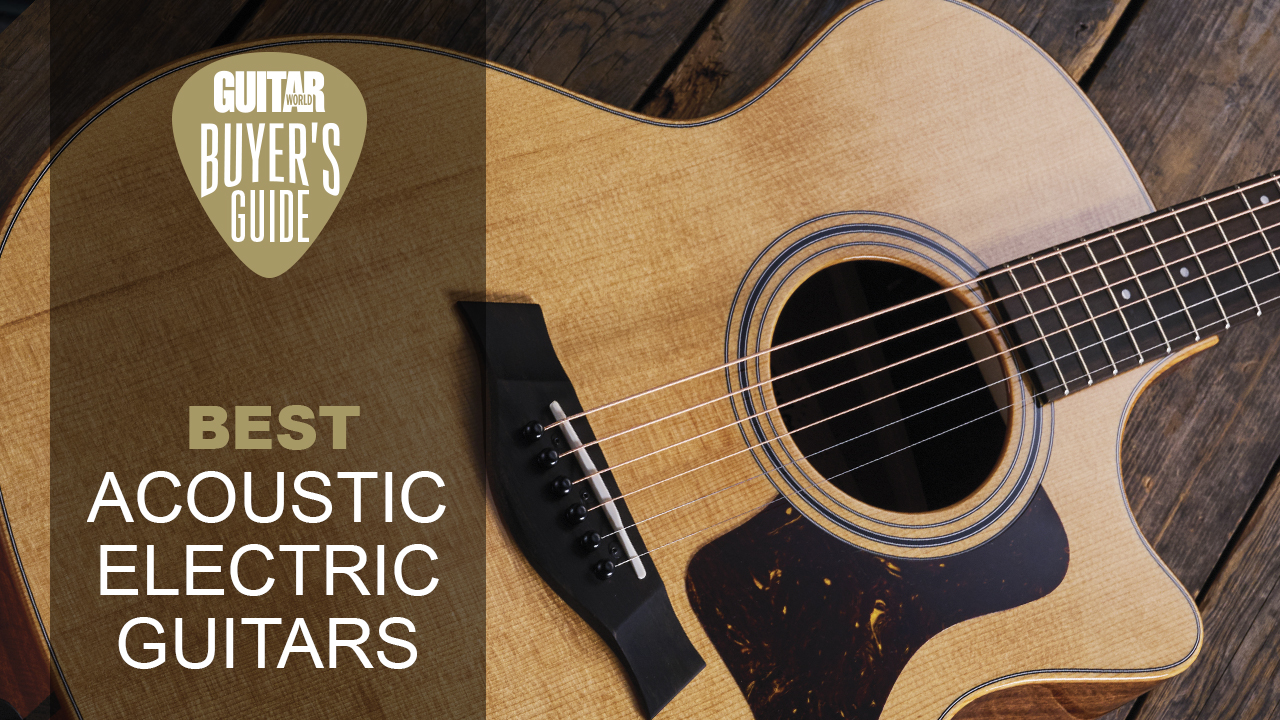
The best acoustic electric guitars offer a level of versatility that regular acoustic guitars cannot match. Unplugged, they reward with the same rich resonance and sparkle that have delighted generations of players. Plugged in, they offer up a whole new world of playing opportunities, whether that’s playing live in front of a large audience or capturing a recorded tone in your home studio.
Visually and tonally, most acoustic electric guitars are almost indistinguishable from their non-electric counterparts. Weight and cost differences are often marginal, leaving little reason not to invest in one.
Acoustic electric guitars come in myriad shapes, styles, sizes, and prices, just as many, in fact, as conventional guitars. This can make choosing the right instrument somewhat overwhelming, but don’t worry, this guide will assist you in finding the best guitar for you, whatever your budget.
To get you started, my top pick goes to the superb Taylor 314cd Studio thanks to it's excellent build quality, playability and affordable price. It's a seriously good guitar.
To help, I've assembled an expertly selected collection of the very best acoustic electric guitars available today, and we’ve included a bunch of useful FAQs to arm you with the knowledge you need.
Our top picks
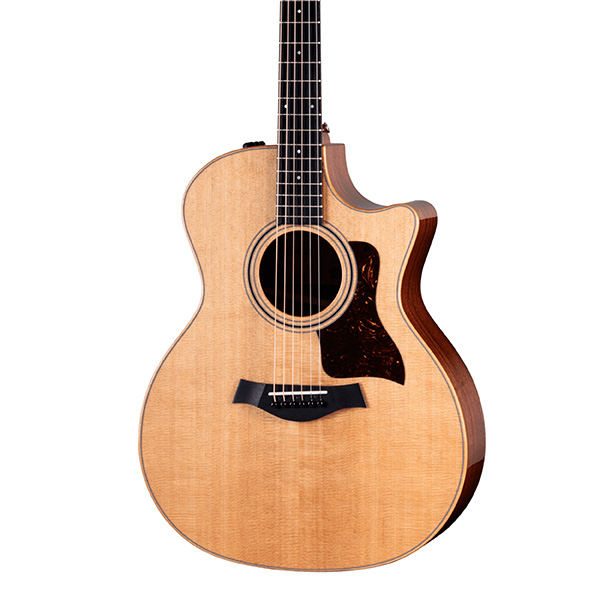
It’s almost impossible to find fault with the versatile Taylor 314ce Studio. Its Grand Auditorium shape offers a voice that’s adaptable enough to tackle almost any style without compromise. Despite its relatively modest price (for a Taylor) it’s fashioned from the best tonewoods and features Taylor’s superb Expression System 2 electronics.

This is a proper Martin at a properly good price. The Martin D JR E is a compact dreadnought-style guitar that just begs to stay by your side, whether you’re relaxing at home, taking a break in the office or travelling. This guitar sounds fantastic, arguably more versatile, and certainly sweeter, than a full-sized dread. It features Martin’s E1 electronics for authentic plugged-in tones.
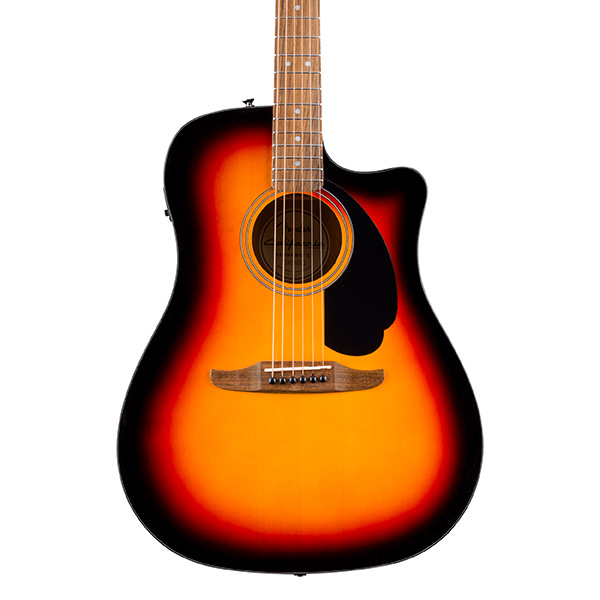
Fender needs to be congratulated on introducing such an addictively playable guitar at a price point that’s so accessible. It sounds just like a good dreadnought should – loud and scooped with a solid dose of bass and a generous sprinkle of top-end sparkle. It is almost beyond belief how Fender has managed to include a decent preamp at this price point.
Best overall
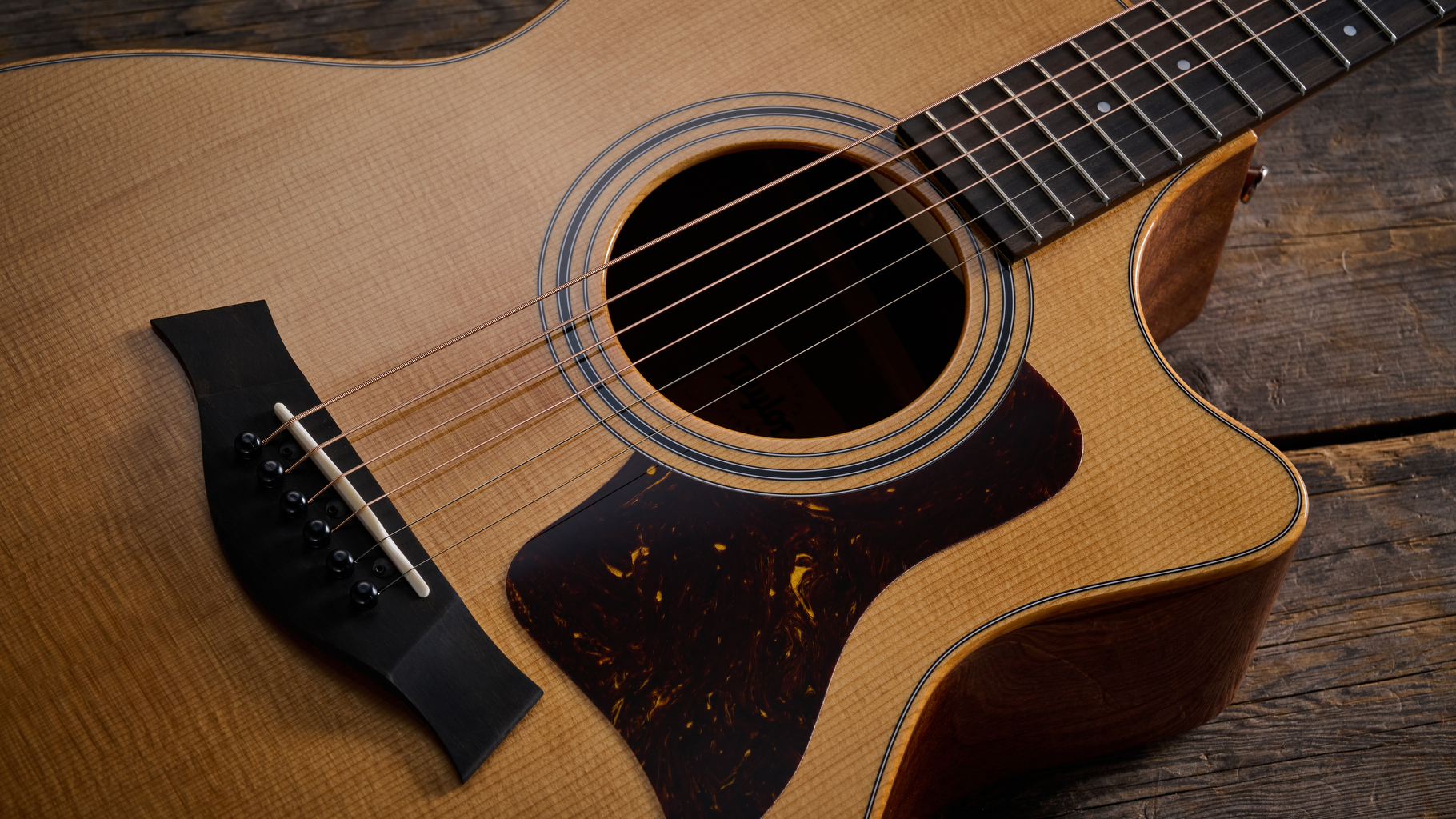
Specifications
Reasons to buy
Reasons to avoid
✅ Buy if you're after an affordable guitar with excellent build quality: This is a top choice whether you're in at home, in the studio or playing live.
❌ Avoid if you want something a little more flashy: The 314ce Studio's minimalist design might be too middle of the road for some players.
Value: ★★★★★
Playability: ★★★★½
Sound: ★★★★½
Overall: ★★★★½
Drum roll please! I present the best overall acoustic electric guitar money can buy – the Taylor 314ce Studio. Sure, it’s not the most expensive guitar, nor is it fashioned from the very finest grade woods or adorned with the most exquisite inlays. Yet, it could very well have claimed the top spot in almost any of the categories featured in this buyer’s guide. Here’s why.
The 314ce Studio is built in Taylor’s iconic Grand Auditorium shape, which is a step down in size from a dreadnought and a step up from the smaller Grand Concert (0 or 00 in Martin-speak). This shape not only produces a balanced, peerless tone, but it’s also incredibly versatile, enabling the 314ce Studio to shine whether you’re playing light, nuanced fingerstyle or bashing out some thunderous chords.
It has the voice, the power and the volume to master any style. Physics dictates that it cannot precisely mimic the signature sound of a dread, jumbo or parlour, but it can get pretty damn close. What’s more, it has its own sweet character that fingerstyle players can’t help but fall in love with.
There are more expensive Grand Auditoriums in Taylor’s portfolio, so surely the higher spec, higher-priced Taylor 814ce will both look and sound better? Probably, but the law of diminishing returns is in full force at these price levels – so the difference isn’t as noticeable as you’d expect. The Taylor 314ce Studio wins because it hits the sweet spot, delivering value, superb build, playability, and tone.
It's affordable for a quality Taylor because the body is crafted in California, while the neck is made in Mexico. It’s also free from any unnecessary adornments, which lends it a sophisticated, minimalist aesthetic. Everything else about this guitar is top-notch – the torrefied solid spruce top, the solid sapele back and sides, the mahogany neck, the West African sustainable ebony fretboard, and the powerful Expression System 2 electronics.

"An agile acoustic with a sparkling voice at an attainable price, the Taylor 314ce Studio proves a worthy investment for home, studio and especially, the stage."
Read more: Taylor 314ce Studio review
Best value
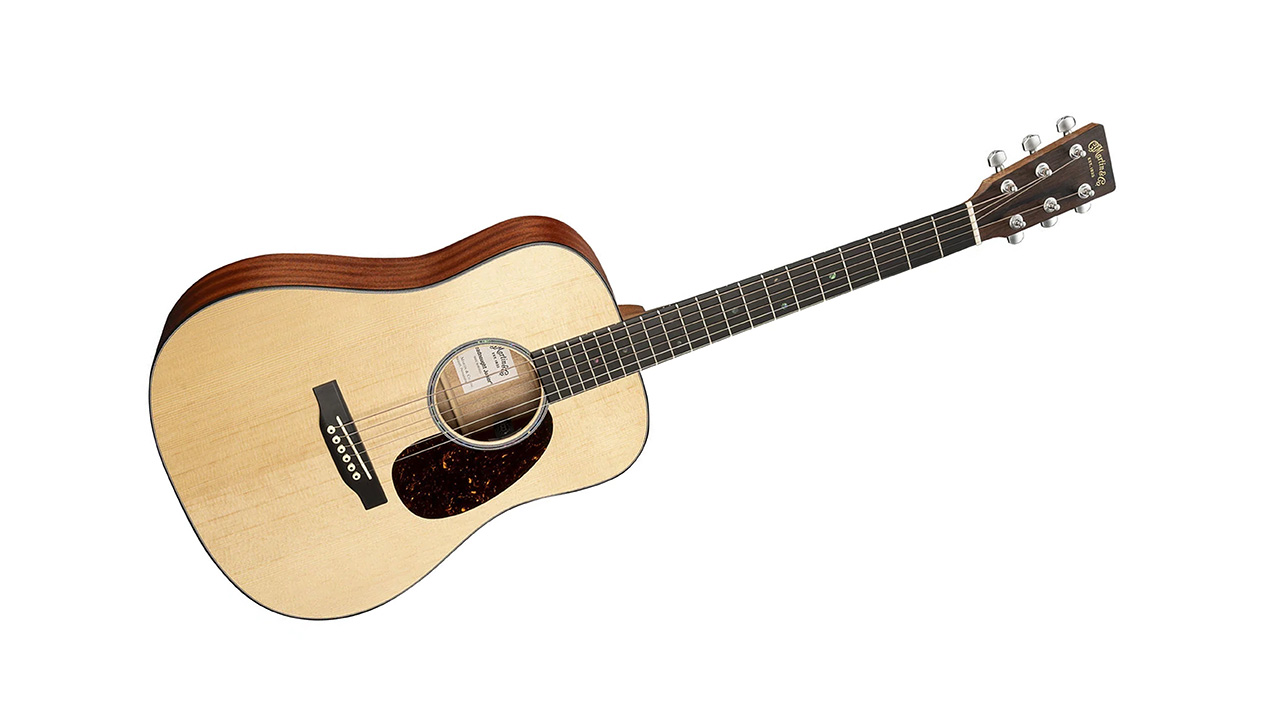
2. Martin D JR E
Our expert review:
Specifications
Reasons to buy
Reasons to avoid
✅ Buy if you're after a compact, slightly smaller dreadnought: For smaller players looking for a great quality dreadnought, this is a nice investment.
❌ Avoid if you want that real dreadnought tone: Make no mistake, this is an excellent guitar, but if you want the real deal tone, then a full-sized dreadnought could be the better option.
Value: ★★★★½
Playability: ★★★★½
Sound: ★★★★½
Overall: ★★★★½
New for 2025, the Martin D JR E is a reboot of the brand’s D JR 10E, a guitar already widely considered superb value for money. Sensibly, Martin hasn’t messed with the format too much, but it has made a raft of improvements.
It takes the dreadnought slot within Martin’s Junior Series, hence the initialism D JR E – Dreadnought Junior Electric, but don’t worry, these guitars aren’t aimed at toddlers. Instead, this is a correctly proportioned guitar that’s been reduced in size ever so slightly to make it a more manageable six-stringed companion to live with.
Whether you keep it by your desk, chuck it in the back of your car or sit with it on the bus, it’s simply a more friendly package to spend time with. Smaller guitarists will also find it less of a handful to play.
At around $700, the cost has been shrunk too. The price is extraordinary for a Martin, and make no mistake, this is a proper Martin. New for 2025, the scale length has been increased slightly, but significantly, from 24” to a more grown-up 24.9”, and the electronics have been upgraded to the brand’s improved E1 system.
Like the rest of the junior series, the D JR E is constructed from solid tonewoods throughout, in this case a spruce top and sapele back and sides. It also features X-bracing, a Martin innovation if ever there was one, and playability is enhanced by its beautifully tapered neck and smooth, bevelled fingerboard edge.
So many travel guitars sound thin and lifeless, whereas the beefier D JR E still retains enough body to enable it to rival the sound of its larger rivals. Its dreadnought character is still evident, but the boom has been replaced with a sweet sparkle. Pick one up at this price and you won’t want to put it down.
Best budget
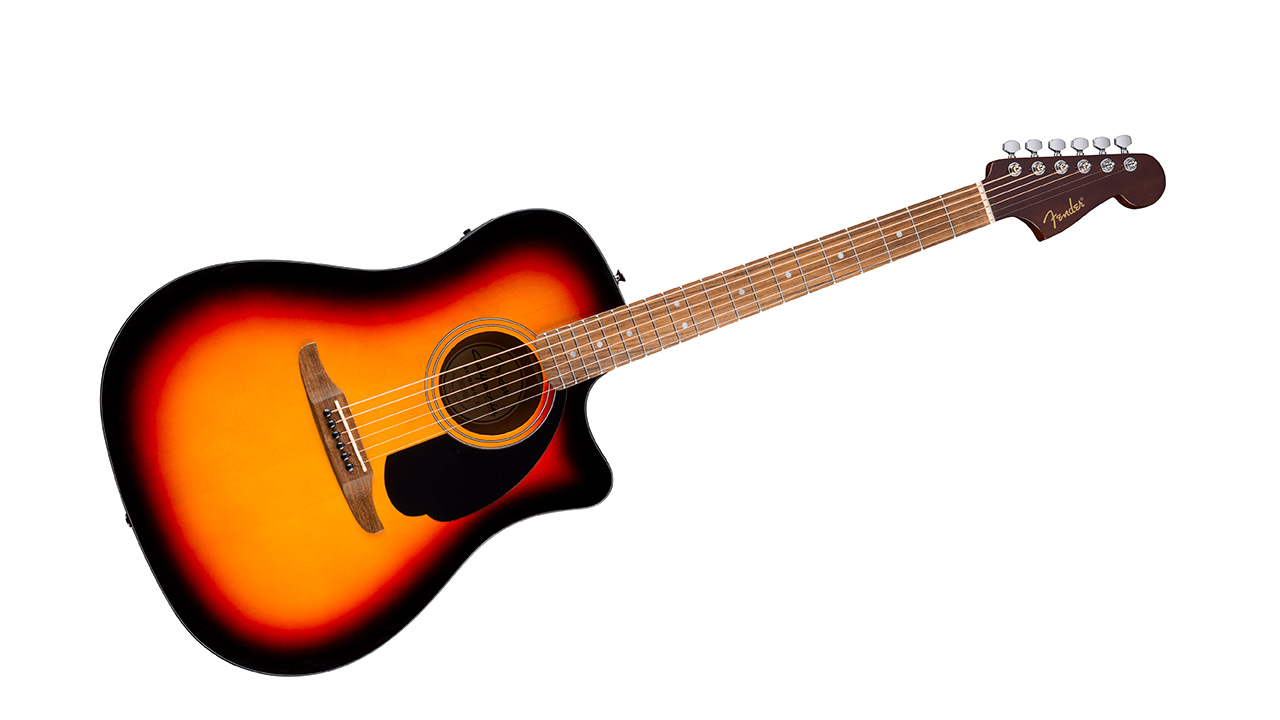
3. Fender California Standard Redondo CE
Our expert review:
Specifications
Reasons to buy
Reasons to avoid
✅ Buy if you're in the market with a guitar with a preamp: The Redondo CE's preamp controls might be on the basic side, but it's a solid inclusion.
❌ Avoid if you're a stickler for tradition: To me, there's something slightly odd about the six-in-a-line headstock on an acoustic.
Value: ★★★★½
Playability: ★★★★½
Sound: ★★★★½
Overall: ★★★★½
The Fender California Standard Redondo CE is part of Fender’s California Series of acoustic guitars, a line that dates back to the sun-drenched, six-string heyday of the 1960s. As luck would have it, the pricing appears to date back to antiquity, too. At around the £200/$200 mark, the Redondo is very competitively priced.
The Redondo is about as dreadnought as a dreadnought gets – all square of shoulder and broad of bout – so there’s plenty of volume on tap, even when unplugged. However, once plugged in it truly springs alive – I struggle to understand how Fender has managed to include a pickup and preamp at this price, but here we are.
Unsurprisingly, the tonewoods are all laminate – spruce for the top and sapele for the back and sides – yet it’s a combination that provides a warm, even tone with enough movement in the top to coax plenty of high-end sparkle.
The slim C-shape neck is hewn from a solid piece of okoume, an African hardwood native to Gabon, while the fingerboard is walnut. Scale length is long at 25.5”, but in the right ballpark for a big dreadnought. The increased string tension injects some brightness, which can help cut through the typically heavy bass.
Nobody questions Fender’s signature six-in-a-line tuners on a Telecaster or a Stratocaster, but when such a headstock is mounted on an acoustic the appearance is always divisive . No matter, they work, which is always a bonus on a guitar this inexpensive.
The preamp controls are basic; there’s just Volume and Tone to play with via a couple of rotary dials, but the implementation is solid enough. There’s also a tuner, which is never a bad thing.
As a package, the Fender California Standard Redondo CE represents a real bang for your buck. The sub-$500 guitar market is an immensely competitive space right now, but with this guitar, Fender leads the pack.
Best for beginners
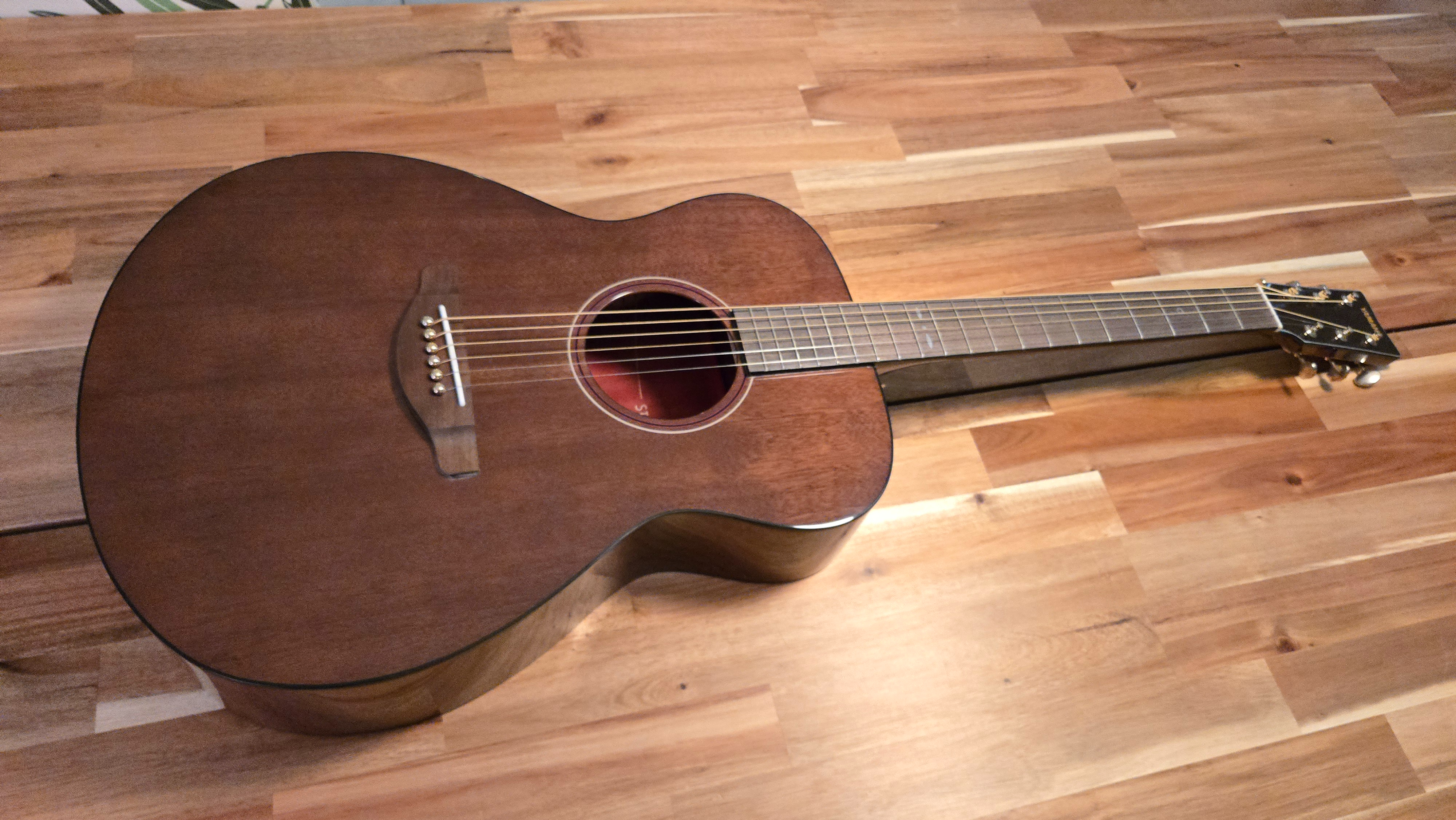
Specifications
Reasons to buy
Reasons to avoid
✅ Buy if you're just starting out on your acoustic journey: Lightweight and well-priced, the Storia III is a wonderful place to start out from.
❌ Avoid if an onboard preamp is on your shopping list: No preamp could be a deal breaker for some, but this remains a rock-solid option for first-timers.
Value: ★★★★½
Playability: ★★★★½
Sound: ★★★★★
Overall: ★★★★½
I look for a good number of qualities before recommending a beginner guitar. It needs to be attractive, bullet-proof, deliver a killer tone, be easy to play, and just as easy on the pocket. The Storia III strikes a series of big, bold ticks through all of these boxes.
Yamaha has developed its Storia line to appeal to new guitarists, introducing an aesthetic that’s boldly modern. While many guitar brands trade on heritage, the Storia treads the opposite path, proving you don’t have to clutter your contemporary home with something that looks like an antique from the turn of the last century.
Yamaha has an enviable reputation for producing well-crafted, reliable instruments that are correctly set up straight from the box. It understands that learning the guitar is challenging enough without being hindered by high string actions and sharp, poorly laid frets. It has taken this sentiment a step further with the Storia series, building them exclusively in Concert size – a medium-bodied shape that’s comfortable for beginner guitarists, whether tall or petite. The scale length, at 25”, is also a little shorter than larger guitars, which reduces tension in the strings.
Unlike a dreadnought or jumbo, models that can sound rather bass heavy; or a small parlour, which can sound tonally thin; the Concert typically has a beautifully well-balanced tone. This, enhanced by the all-mahogany build, makes the Storia an incredibly versatile instrument, perfect for beginners who will want to experiment with a broad range of musical styles.
On that note, the guitar’s body incorporates an undersaddle pickup, which will enable you to plug in for an amplified sound. There’s no preamp, but this simple setup is more than good enough for your first forays into playing live.
This is not a cheap guitar, but it does represent excellent value for a quality instrument that will serve you well into your intermediate years as a guitarist.

"The Yamaha Storia III looks and feels different to your standard beginner models. But its lightweight build and distinctive looks come together to offer a well-thought-out, hugely rewarding package to play."
Read more: Yamaha Storia III review
Best for intermediates
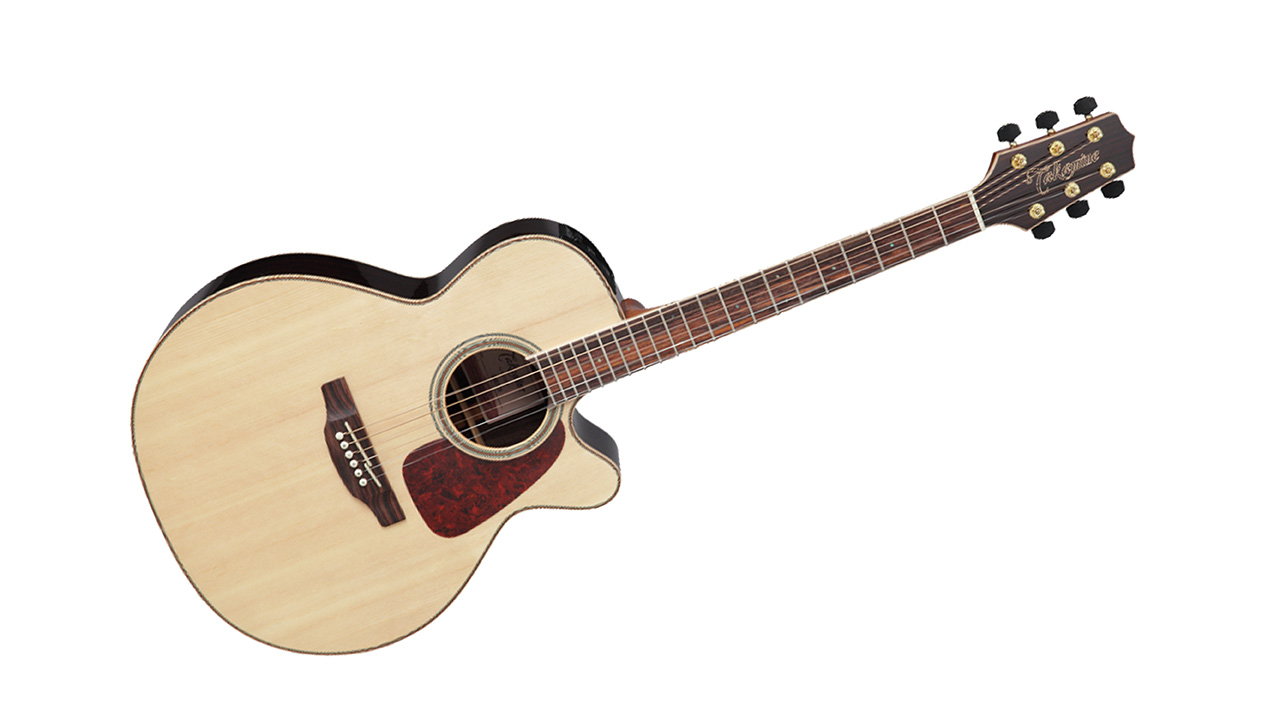
5. Takamine GN93CE
Our expert review:
Specifications
Reasons to buy
Reasons to avoid
✅ Buy if you're looking to upgrade your first guitar, but don't want to spend a fortune: The GN93CE is beautifully crafted and performs way above its price point.
❌ Avoid if a more recognisable brand is your preference: It's hard to criticise this guitar, but if branding is important, this may not be for you.
Value: ★★★★★
Playability: ★★★★½
Sound: ★★★★½
Overall: ★★★★½
Here’s a guitar that truly punches above its weight. As an intermediate, you may be tempted to spend a little more money, but I urge you to at least consider the GN93CE – you could save yourself a heap of cash. Equally, if you’re a novice guitarist looking to invest in an instrument that'll last you several years, this is an excellent buy for you too.
Takamine may lack the prestige of US brands such as Martin and Gibson, but like its Japanese peers Yamaha and Ibanez, it enjoys a strong reputation for innovation, quality and value. The catchily-named GN93CE, which sits within the brand’s affordable G-Series line, is a great example. It’s been knocking around for a few years now, but that’s just testament to its popularity.
It's shaped somewhat like a jumbo that’s been taken in at the waist, then shrunken in size. Takamine calls this its NEX body, a shape the brand introduced in 1992 to overcome the bass bias and overt percussiveness of dreadnought and jumbo guitars. The resulting tone is more balanced, but there remains enough midrange scoop to make NEX-bodied guitars popular with vocalists, many of whom also value the narrow waist because it makes these guitars very comfy to play seated. Like many mid-sized guitars, the GN93CE is a flexible beast, capable of handling many different genres.
Tonewoods are unusual in that the top is solid spruce – no great surprise there – but the back and sides are a combination of black walnut and maple. The back is actually crafted from three-pieces, including a large, central dart of figured maple that contrasts beautifully against the walnut on either side. I suspect the maple is a nod to the GN93CE’s jumbo roots, it’s a tonewood often used in these big guitars to introduce some top end sparkle.
The slim tapered neck is mahogany, with a 12”-radius laurel fingerboard that’s beautifully bound in cream. This guitar is a real looker, the neck and headstock bindings; the dark wood rosette and body purfling; the abalone dot inlays and the gold die-cast tuners – all conspire in the illusion that this is a much pricier instrument.
Contributing to that deception is the fully-featured Takamine TK-40D preamp system, which boasts a three-band EQ and gain controls, a mid-contour switch, a notch filter, an EQ bypass switch and a built-in tuner.
The Takamine GN93CE is a giant leap up in quality from a beginner’s guitar, yet only a small step up in price. I especially recommend it for singer-songwriters.
Best for pros
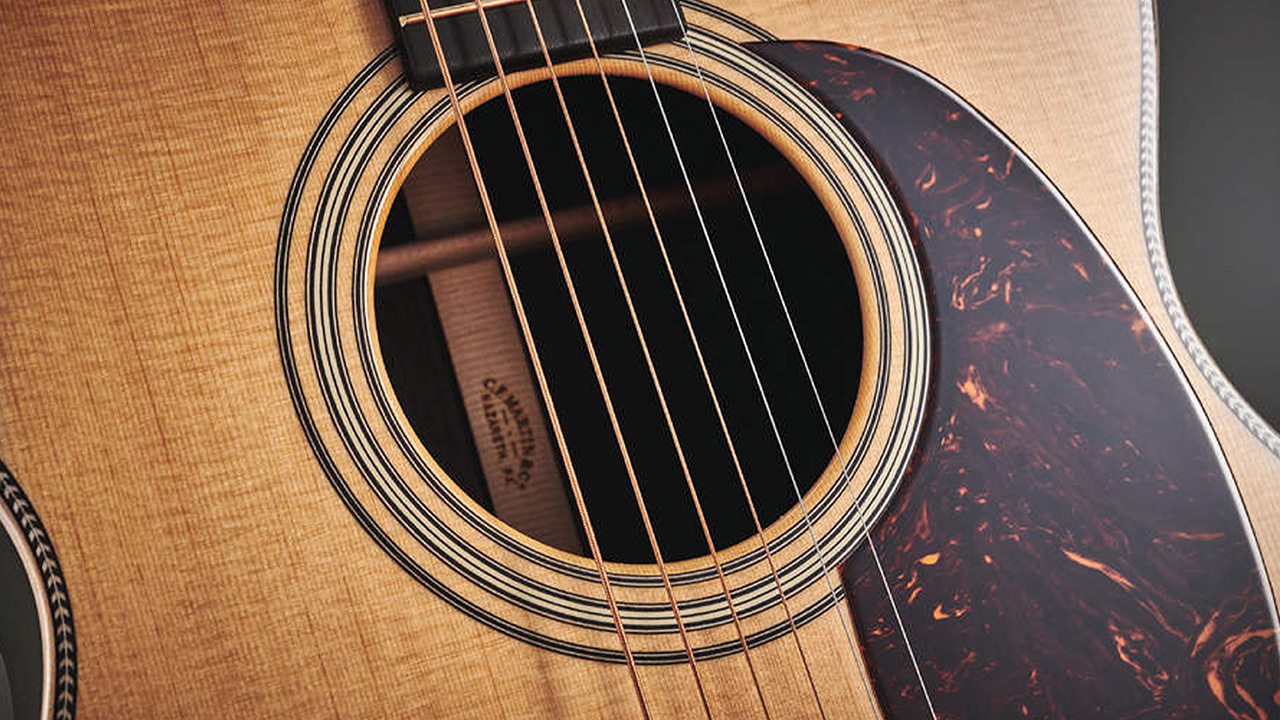
Specifications
Reasons to buy
Reasons to avoid
✅ Buy if you're looking for balanced tone right across the board: This Martin is a workhorse and provides a rich, sweet sound.
❌ Avoid if you're on a budget: The price point on the Martin 000-28 Modern Deluxe will be off-putting to some.
Value: ★★★★
Playability: ★★★★½
Sound: ★★★★½
Overall: ★★★★½
As the name implies, this is a thoroughly contemporary take on Martin’s venerable 000-28, a model it introduced way back in the mid-1920s. The 000 designation tells us that this guitar is a compact Auditorium model, which, paired with the time-honoured combination of spruce top and rosewood back and sides, delivers a bewitchingly balanced tone across all six strings.
The numerals 28 reveal it sits mid-way in the brand’s portfolio of regular, production-line instruments. Generally speaking, a higher number would suggest more expensive embellishments and appointments, which can look drop-dead gorgeous but often return little improvement in tone.
In short, this suggests the humble (for a Martin!) 000-28 is the perfect pros guitar, a versatile workhorse, for which every penny has been invested in tonal quality rather than fancy, yet largely superfluous adornments.
Yet, as a Modern Deluxe version, it’s so much more than that. To enhance its tonal character to 11, the 000-28 Modern Deluxe’s solid spruce top is ‘aged’ with Martin’s Vintage Tone System, the brand’s sophisticated take on torrefaction. ‘Liquid Metal’ bridge pins, made from zirconium alloy, reflect string energy rather than absorbing it, thereby increasing volume, sustain, and dynamic response. To the same end, the bridgeplate is made from composite carbon fibre. Additionally, to nail your live/recorded tone, you can specify one of four different Fishman mic and preamp options.
Visually, the 000-28 Modern Deluxe also receives some tasteful upgrades, including a European flamed maple binding, gold frets, gold open-gear tuners and a 1930s-style script logo inlaid in pearl on the headstock. Who said a workhorse can’t possess the looks and spirit of a thoroughbred?
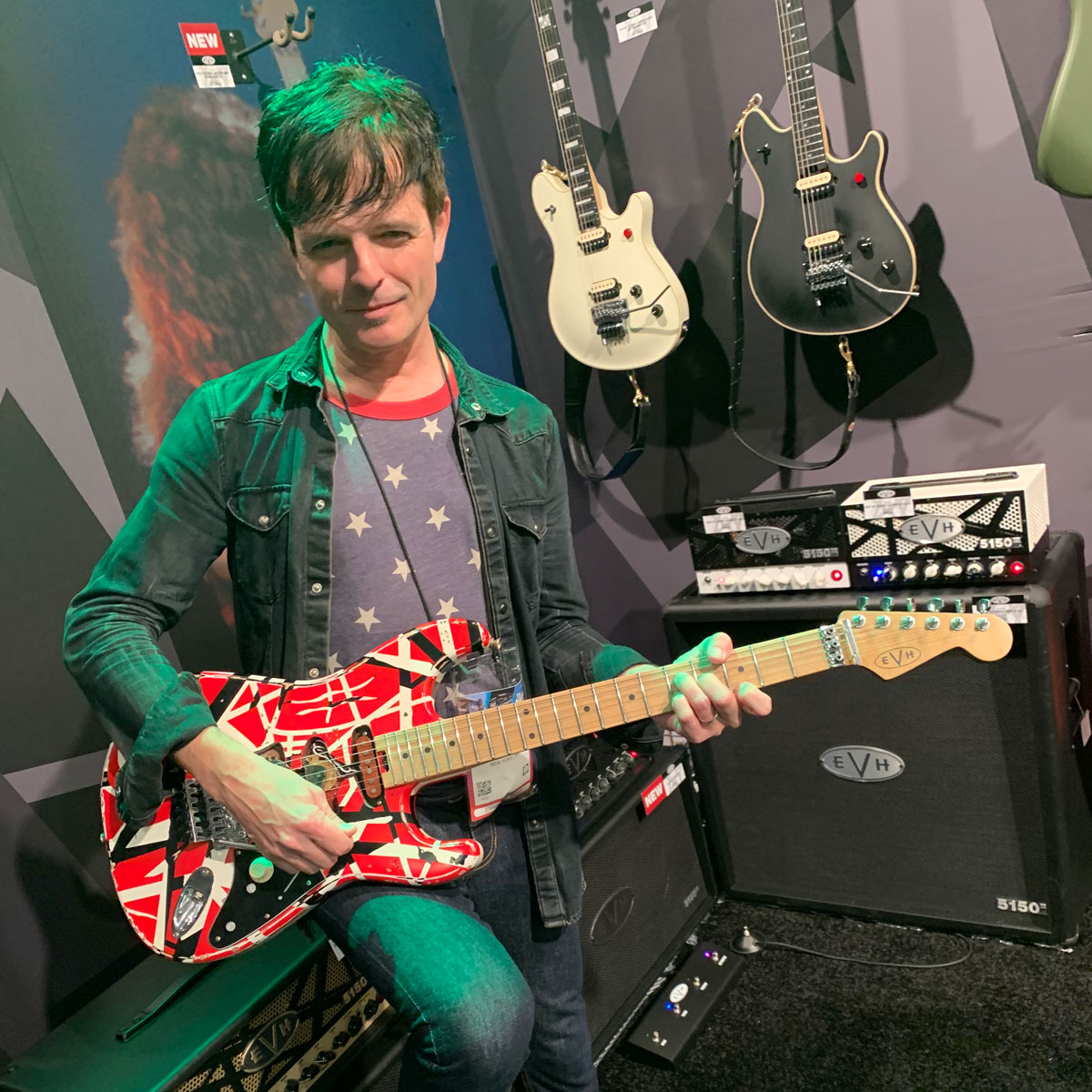
"Possessing a clear harmonic range, ultramodern features and vintage-style appointments, the Martin 000-28 Modern Deluxe is by far one of the most responsive and satisfying acoustics available."
Read more: Martin 000-28E Modern Deluxe review
Best pick-up/preamp
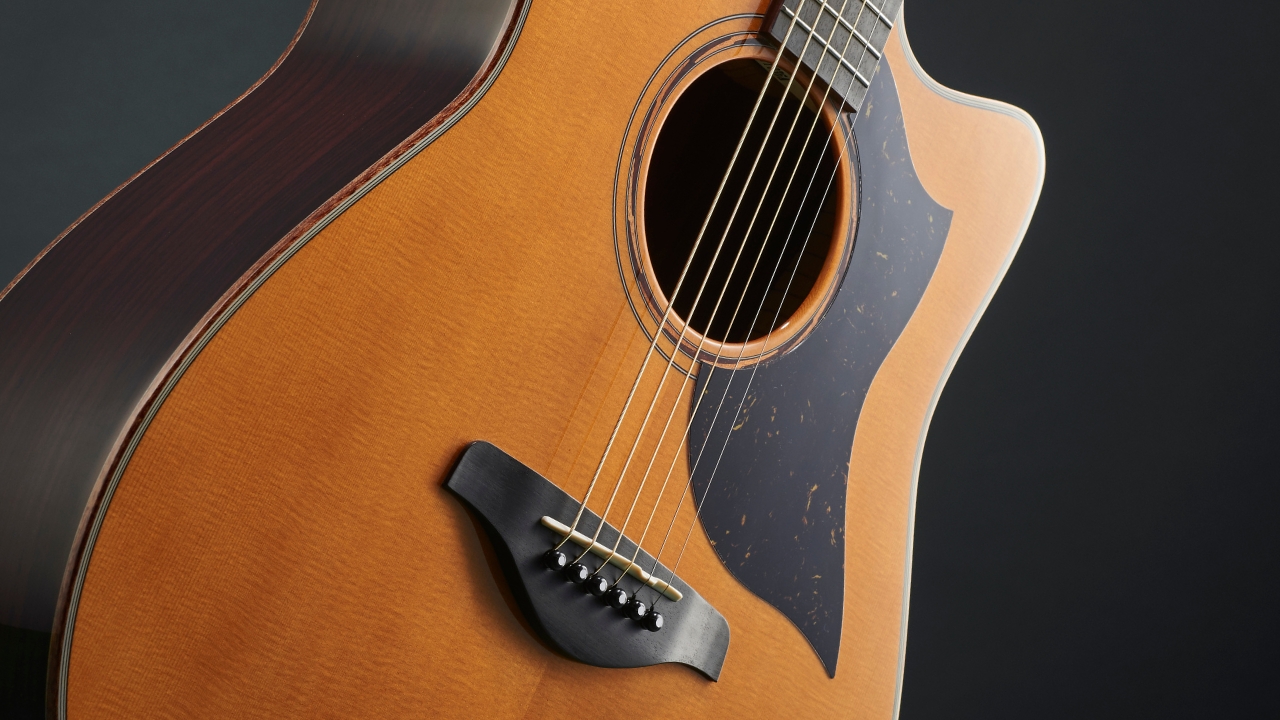
Specifications
Reasons to buy
Reasons to avoid
✅ Buy if you want to add a classy Yamaha to your collection: The A5R ARE is a truly special guitar that is great for recording and gigging.
❌ Avoid if you're a new player: The on-board electronic might be a bit too much for new players.
Value: ★★★★½
Playability: ★★★★½
Sound: ★★★★½
Overall: ★★★★½
Yamaha’s A Series guitars have been developed for just one purpose – performance. From the ground up, they’ve been voiced, built and wired for the road and studio. The A5 sits at the pinnacle of the range, a showcase instrument that’s a fabulous acoustic guitar in its own right. However, it’s Yamaha’s rather clever proprietary SRT2 Electronic pre-amp and mic modelling system that makes this guitar truly special. First though, let’s take a look at the instrument unplugged.
The A5R ARE is a dreadnought-shaped acoustic that, like all high-end Yamahas, is built in the brand’s workshops in Japan. It features solid tonewoods throughout, namely a hand-selected, torrefied Sitka spruce top, rosewood back and sides, a three-ply mahogany neck and a hand-rolled ebony fingerboard. The bracing, unique to the A Series, is scalloped for the top and shortened for the back to allow the soundbox to vibrate more freely than it would otherwise. This results in better projection, more volume and a tonal boost for the low end.
Now for the clever bit. Yamaha’s SRT (Studio Response Technology) is a sophisticated pickup and preamp system that leverages digital modelling to recreate the sound of a miked acoustic guitar. It comprises two elements, a high quality undersaddle piezo pickup with separate elements for each string, and a preamp with powerful DSP capabilities.
Strike a chord on the A5R ARE and the vibrations will be captured by the piezo mic, at which point the SRT’s DSP blends the signal with a modelled guitar tone that’s based on a precisely placed pro mic. In fact, you can select one of two microphones, either a Neumann U67 Large Diaphragm Condenser or a Royer R122 Active Ribbon.
The result is a tone that has the sonic depth and dynamic range of a guitar recorded in a professional studio, using a complex mic placement. The primary benefit for touring musicians is that it’s now possible to achieve a killer sound wherever or whatever the venue.
If SRT sounds complex, well it is, but don’t let that put you off, because the implementation is both simple and intuitive. There are just four rotary controls to play with, including the familiar volume, treble, and bass. The fourth rotary control simply blends the piezo/modelled sound to taste, and switches between mics with a push/pull action.
Best dreadnought
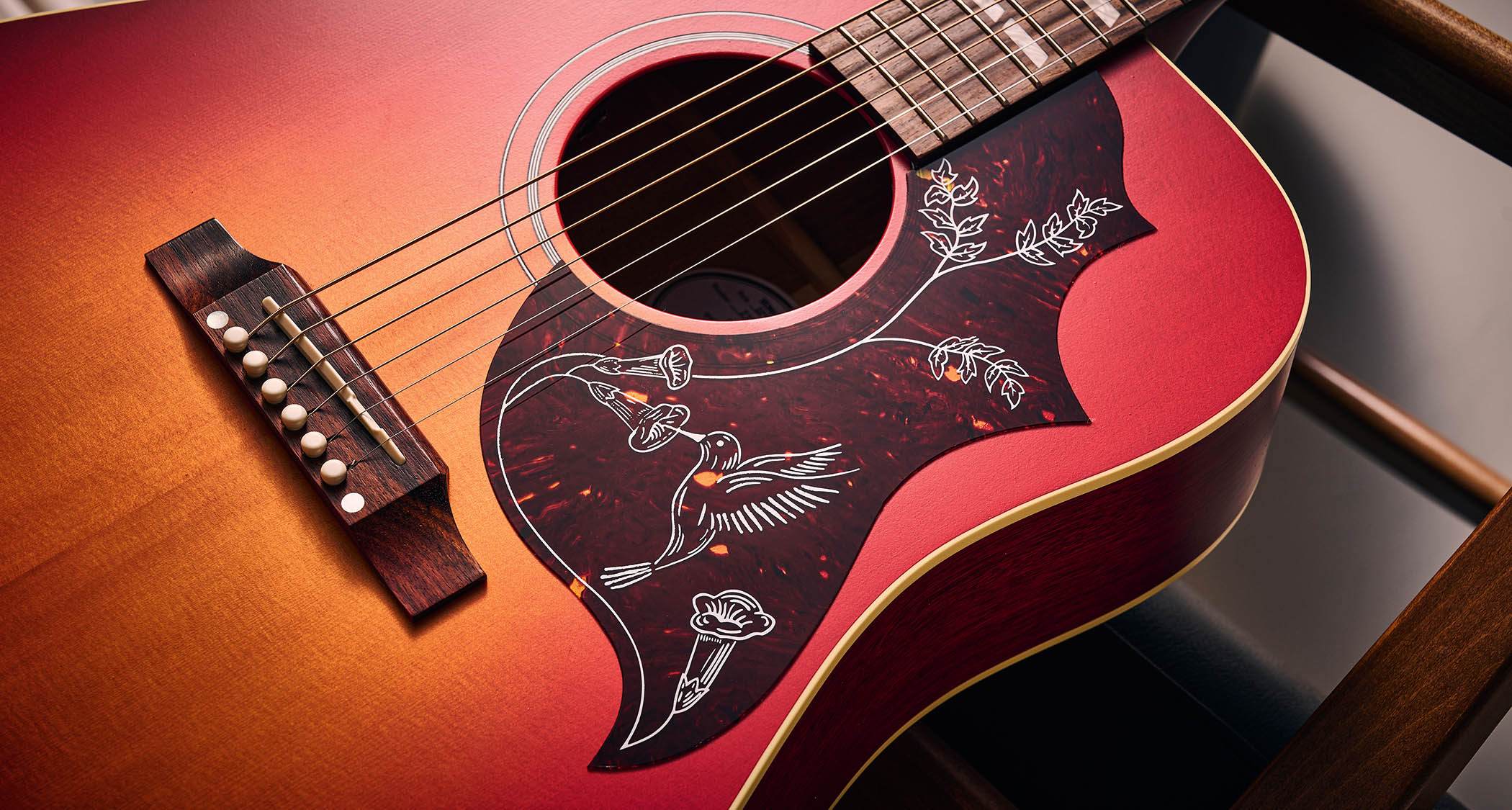
Specifications
Reasons to buy
Reasons to avoid
✅ Buy if you want a fabulous Gibson dreadnought: This is a top-tier dreadnought that performs absolutely beautifully.
❌ Avoid if you're after a more traditional design: OK, I'm nit-picking here, but the Hummingbird design might not rock your world.
Value: ★★★★½
Playability: ★★★★
Sound: ★★★★
Overall: ★★★★
Martin invented the dreadnought in the very first half of the last century, just as the Jazz Age was limbering up. Its D-28 is the definitive dread, arguably the most iconic steel six-string ever, so why in all that’s sacred is a Gibson taking top honours in this category?
Well, Gibson guitars and a hefty price tag often go hand-in-hand, so when this great value Hummingbird fluttered onto my radar, it was too good to pass up. Make no mistake, this isn't some watered-down version of a Hummingbird; it's a full-on, honest-to-goodness Gibson. We're talking USA-made, solid tonewoods, quality electronics, and a gorgeous premium satin nitrocellulose lacquer finish. What’s more, it’s about half the price of a regular Hummingbird Standard, or a Martin D-28, for that matter.
So, what's the catch? Honestly, there isn’t one. No corners have been cut or Hummingbirds harmed in the making of this series. The same luthiers in Bozeman, Montana – the team behind all Gibson acoustic guitars – are the ones crafting these Specials. And the build? It's pretty much classic Hummingbird through and through – a solid Sitka spruce top, mahogany back and sides, scalloped X-bracing, and a neck attached to the body with a compound dovetail joint.
If there's one notable departure, it's the ‘concert depth body’, which is a touch less deep than that of the Hummingbird Standard. However, Gibson claims this subtle tweak delivers a tighter bass response.
Neville Marten, who put this guitar through its paces for Guitar World, found it felt remarkably similar to his own Custom Shop Hummingbird – a guitar he describes as a "breeze to play and never becomes tiring." Reviewing it alongside Gibson's similarly priced J-45 Special, Marten noted, "There’s no doubting that they have that signature Gibson tone. We’d actually been playing the guitars for a good 30 minutes before the penny dropped that they were a smidge shallower…" He then added that the Hummingbird is "definitely the fatter and warmer of the two, making it a brilliant strummer."
The Gibson Hummingbird Special may not be the obvious choice but, at this price, it’s too good to miss.

"While the odd corner has clearly been cut, remember this is a true Gibson with all the individuality that this brand exhibits, arguably over all others. They’ve definitely fulfilled their ‘good guitar on a budget’ remit and, although I wasn't so sure at first, it looks like I might just have made a new best friend."
Read more: Gibson Hummingbird Special review
Best for fingerstyle
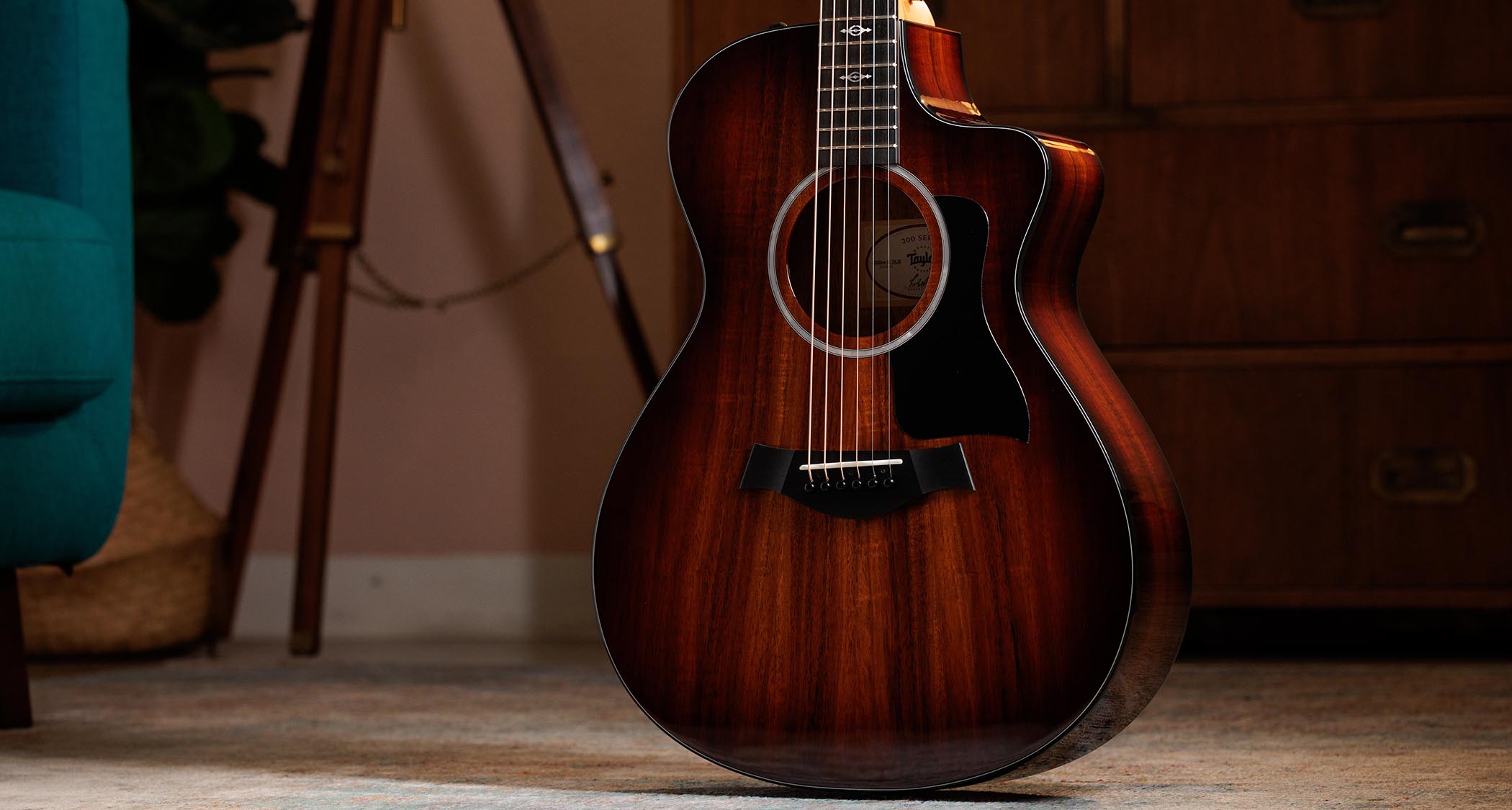
Specifications
Reasons to buy
Reasons to avoid
✅ Buy if you want a premium guitar for a good price: The tone on this guitar astonishing and you're getting very good value for money.
❌ Avoid if fingerstyle playing isn't your thing: There are other models in the list that are cheaper and will suit you better.
Value: ★★★★½
Playability: ★★★★½
Sound: ★★★★½
Overall: ★★★★½
The modestly proportioned Grand Concert guitar shape is, without doubt, the apex form factor for fingerstyle. Similarly, koa, a dense, tropical hardwood, delivers the finest fingerstyle tone around... period! Together, they’re a match made in heaven – a symphony of strings, a radiant reverberation of rapture.
I am, of course, playfully exaggerating in the most nauseatingly saccharine way possible. However, the two elements – the shape and the tonewood – work so well together that many regard a good Koa Grand Concert as the definitive fingerstyle guitar. The issue is cost, as koa builds can be ruinously expensive.
Unless, that is, we’re talking about Taylor’s 222ce-K DLX, a grand concert guitar for well under two grand. Taylor’s Grand Concert series, identified by the number two in the third digit of the model number, is the brand’s smallest full-size guitar shape, explicitly developed for the fingerstyle player. Its modest size contributes a sparkly, articulate sound that plays well with koa’s sweet, chiming nature, one that warms up considerably once the wood has matured, but never overbearingly so.
Taylor has kept the cost down by building this guitar in Mexico, and pairing the solid top with ‘layered’ back and sides, which we interpret as laminate. Nevertheless, the tone is astonishing. “The treble has a sweet, alluring chime that accentuates upper spectrum harmonics but never sounds thin,” commented Chris Gill when reviewing the 222ce-K DLX for Guitar World, adding, “the warm, full midrange and focused bass will certainly please traditionalists.”
The amplified sound comes courtesy of Taylor’s excellent Expression System 2, which comprises a three-sensor behind-the-saddle pickup, combined with its patented preamp. Playing with the three rotary dials, for volume, treble and bass, it’s intuitively simple to dial in some delightfully complex tones.

"By offering a true all-koa body guitar at a significantly reduced price, Taylor has made it easier than ever for guitarists to experience the alluring “goldilocks” tonal qualities of a koa acoustic."
Read more: Taylor 222ce-K DLX review
Best jumbo
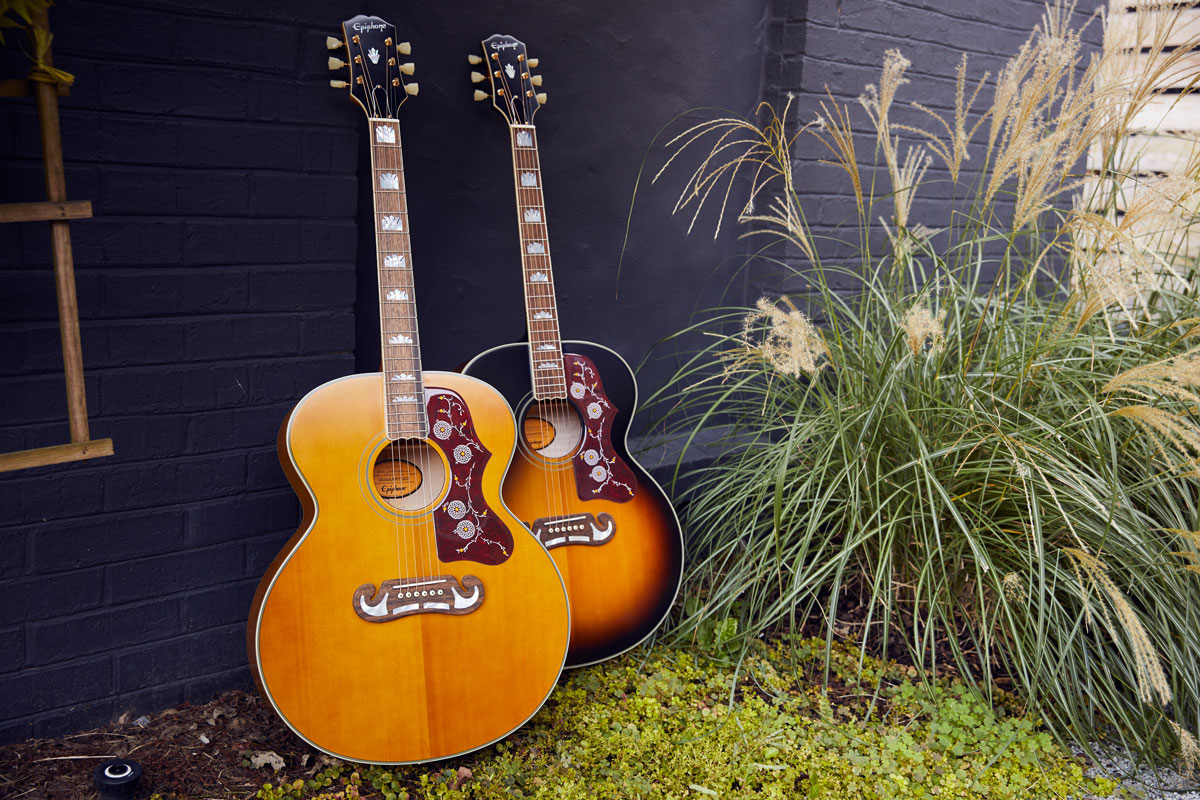
Specifications
Reasons to buy
Reasons to avoid
✅ Buy if you want that authentic J-200 tone for less: It's a copy, sure, but a very good one and a jumbo that won't let you down.
❌ Avoid if you simply want a Gibson: A Gibson will be priced higher, but if that's what you're looking for, then this might not fit the bill.
Value: ★★★★★
Playability: ★★★★½
Sound: ★★★★★
Overall: ★★★★★
Fittingly, the Gibson J-200, nicknamed the King of the Flatops, has been the guitar of choice for a very long list of country and rock royalty. Ray Whitley, Tex Ritter, Gene Autry, Elvis Presley, Emmylou Harris, Pete Townsend, Neil Young, Bob Dylan, George Harrison, Jimmy Page, John Lennon, Sheryl Crow, The Edge and Chris Martin, to name but a few, have all laid down tracks with Gibson’s Super Jumbo.
Originally introduced in 1937 to compete with Martin’s successful line of dreadnoughts, a J-200 (aka SJ-200, as in Super Jumbo) has a very different sonic signature compared to a dread such as a D-28. Loud and powerful, with a strong low end yet retaining a relatively balanced tone, jumbos are valued for their clarity, a quality born of their narrow waist and maple construction.
This guitar, of course, is an Epiphone, a sister brand of Gibson’s known for its more affordable instruments. Where a Gibson SJ-200 will set you back at least £4,000/$4,000, this guitar is much more accessible at less than a quarter of that price. However, fewer corners have been cut than you may imagine, which is why I've included it as my choice jumbo. Epiphone must be applauded for producing an SJ-200 that’s about as authentic as it gets without a Gibson logo inlaid on the headstock.
The build is spot on regarding tonewoods. A solid Sitka spruce top sits on a solid maple body, attached to which is a two-piece maple neck with a mahogany centre strip. All the iconic appointments are present and correct – the moustache bridge with curved block inlays, crown headstock inlay and graduated crown mother of pearl fingerboard inlays, and a J-200 style pickguard with two-colour graphics. The electronics are a class act too, comprising a Fishman® Presys VT™ undersaddle pickup paired with a Fishman Sonitone preamp.
The Epiphone J-220 may not be completely authentic, but it is a very honest tribute to the original King of the Flat-Tops. It’s a genuinely great guitar.

"The Epiphone Inspired by Gibson J-200 closely captures the irresistible tones and appealing mojo of the original at prices that won’t break the bank."
Read more: Epiphone Inspired by Gibson J-200 review
How to choose the best acoustic electric guitar
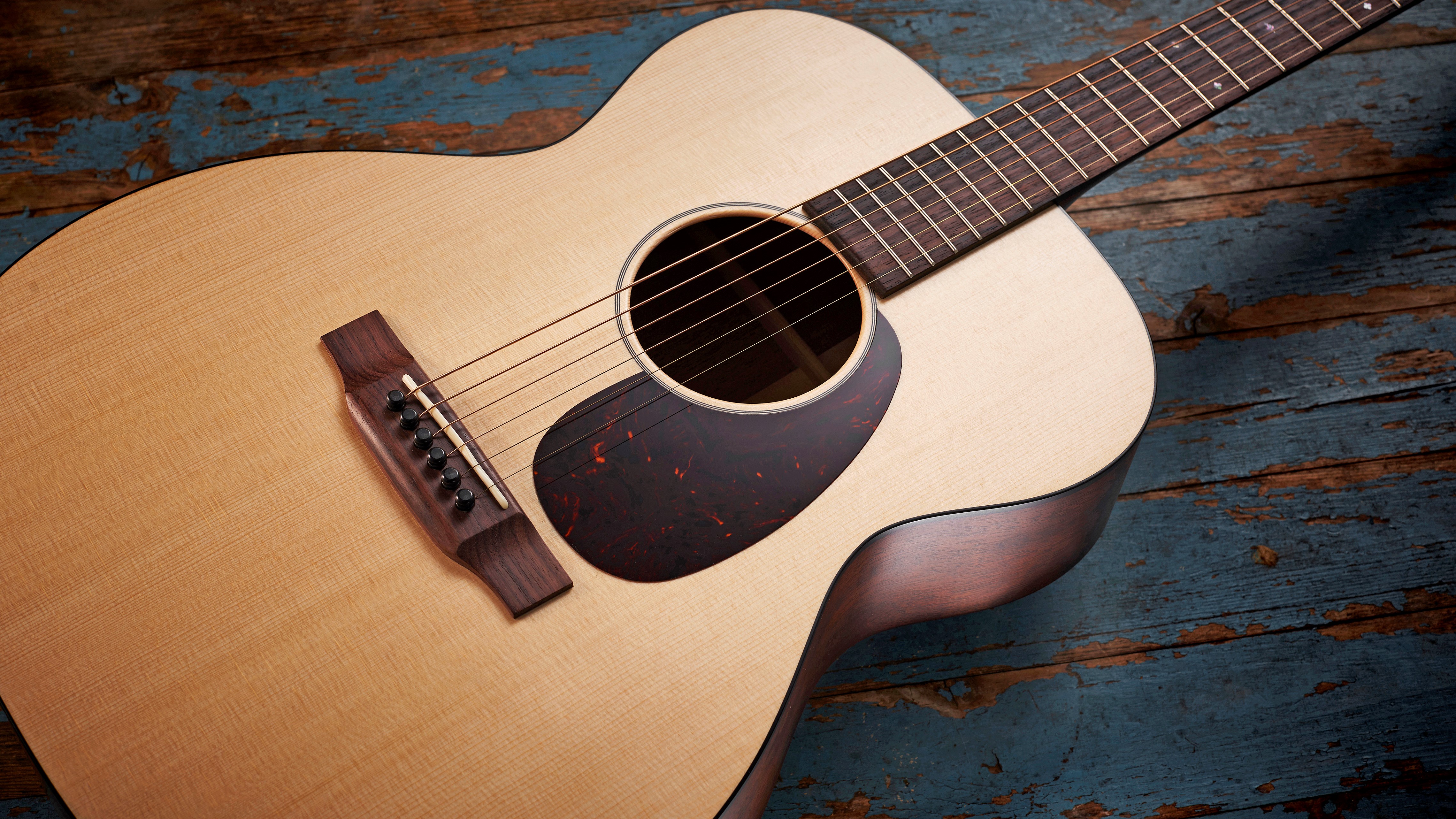
Buying an acoustic electric guitar is very similar to purchasing a conventional guitar; the same principles apply. By thinking about the genre of music you intend to play and considering the budget you have available, the whole buying process should fall into place.
Start by picturing the music you want to play because this should, within reason, dictate your preferred guitar’s shape and size. If you’re planning to strum enthusiastically to songs you enjoy singing, then a dreadnought, one of the most popular guitar shapes, is the guitar for you. Big and loud, with a bold bottom end and loads of clarity in the highs, the dread has slightly scooped mids, which leaves plenty of room for vocals. It’s a singer-songwriter’s dream.
A jumbo, with its large, curvaceous body, is similarly loud but exhibits more pronounced bass tones as well as shimmering highs. It’s also great for strumming and cuts through a mix particularly well. The jumbo is a favourite for country and pop – think Nashville stars such as Emmylou Harris or cross-over musicians such as Sheryl Crow and Taylor Swift.
If your favourite pieces are more nuanced, such as fingerstyle, then a slightly more compact guitar, such as a concert, grand concert, or grand auditorium will suit you better.
Parlour guitars are smaller still and often have a mid-heavy sound, which makes these diminutive guitars a fantastic choice for genres such as blues. They are also easier for smaller players to get their arms around. With the non-electric versions famously lacking in volume, modern onboard electronics now present the Parlour sound to a bigger, broader audience.
Tonewoods – spruce, mahogany, maple and the like – can influence a guitar’s tonal characteristics almost as much as shape, so take this into consideration when picking a guitar. You can read all about the influence of different tonewoods in our FAQs.
It is, of course, possible to play any music on any guitar, so don’t get too hung up on ‘rules’. Remember, whatever feels comfortable is comfortable, and whatever sounds great is great. If you’re a smaller player, a compact grand auditorium guitar is a very versatile instrument that will likely be more comfortable to play than a dreadnought or jumbo, yet it will sound right at home, whatever the genre.
Finally, take a good look at the electronics. Most acoustic electric guitars feature an undersaddle piezo pickup, teamed with a preamp to boost and shape their tone. More basic installations may just feature an undersaddle pickup, while more sophisticated setups could comprise multiple pickups, a preamp, a multiband EQ and even a small condenser microphone concealed in the guitar’s body. Don’t worry, all will provide you with an amplified tone, but quality and tonal characteristics will vary from one system to the next. Be sure to read the entry in our FAQ to determine which solution is best for you.
FAQs
Why do I need an acoustic electric guitar?
Simply put, an acoustic electric guitar presents opportunities that a traditional acoustic cannot compete with, unless modified with a pickup and preamp at some point in its life. If you’re a seasoned player, perhaps a singer-songwriter, already performing on a gig circuit, then an acoustic electric guitar is a no-brainer – your need is indisputable.
For beginner guitarists, or intermediates, who haven’t played to anyone beyond their circle of close friends and family, an acoustic electric is still an astute purchase. It will be ready when you are, but until that time, you can play it unplugged – it won’t hold you back in any way.
In fact, there’s no downside to owning an acoustic electric guitar. The electronics in the majority of modern guitars are super discreet, so much so, it can be almost impossible to tell electric and non-electric models apart, bar a low-profile rotary knob or two on the upper bout. The increase in weight is usually negligible too – a piezo pickup weighs almost nothing and the heaviest part of a preamp will be the 9v battery (40g) used to power it.
Cost, as a percentage of the total price of a guitar vs a non-electric version, is also insignificant, particularly at the budget end of the market, which currently offers exceptional value.
Perhaps, the more persuasive reason for buying an acoustic guitar is that, chances are, at some point in your life as a guitarist you will need one. Or, at the least, you’ll want one. At this point, you’ll have three choices, none of them cheap. One, you take a hit trading your existing guitar for a new electric model; two, you buy a second guitar; three, you install electronics in your existing guitar.
The third option is the least expensive out of the three, but you’d better have a steady hand because you’ll be taking a drill to your beloved guitar. The best option, of course, is to invest in an acoustic electric guitar in the first place.
What are the different types of acoustic guitar pickup?
Acoustic guitar pickups generally fall into three broad categories – electromagnetic, piezoelectric and microphone. All have their advantages and disadvantages, which is why it’s not uncommon to find a combination of pickups installed in more expensive instruments.
Electromagnetic
Magnetic pickups are similar to those found on electric guitars, they even resemble the single-coil bars commonly seen on single-coil guitars such as Fender Teles and Strats. Essentially, an electromagnetic pickup is nothing more complex than a length of insulated copper wire wrapped around six magnetic poles, one for each string.
When placed beneath the strings, usually almost flush with the soundhole, an electromagnetic pickup will convert the vibration of the strings into an electric signal, which once boosted by your amplifier, will be converted back into audible sound by its speaker. They are passive, so require no power.
Unfortunately, electromagnetic pickups only represent the sound of the strings, not the resonance from your guitar’s body, which is where most of its complex tone is generated. Many believe they can look unsightly on an acoustic too, so although they’re a popular aftermarket addition, it’s now unusual to find them factory fitted to new guitars.
Piezoelectric
Piezoelectric, or piezo, pickups have evolved to become the most commonly installed factory-fitted pickup type. They work on the basis that certain crystals – commonly quartz, lead zirconate and lead titanate – will produce a voltage when mechanically stressed. On this basis, a piezo guitar pickup comprises a thin strip of piezoelectric crystals, one for each string, that’s commonly factory-installed beneath the guitar’s saddle, hence the term ‘under saddle pickup’. Plucking a string will ‘stress’ the relevant crystal into emitting an electrical signal, which is output to your amp, mixer or PA.
Piezo pickups are small, passive, inexpensive, resistant to feedback and easy to conceal, which explains their popularity. Unfortunately, they also only capture energy from the strings, rather than the whole guitar body, which lends them a clinical sound that’s often considered ‘quacky’.
However, a good preamp can significantly enhance this sound.
Microphones
Microphones come in two flavours, contact and condenser. As the name suggests, contact mics are attached to the surface of the guitar’s soundbox (body), often with glue/gel/gum but hook and loop or adhesive tape can be used too. They’re small – often the size of a coin – passive and easy to conceal.
Contact mics will capture the full sound of your guitar, but bear in mind that they are very prone to handling noise too. However, this can be a distinct advantage for percussive styles of playing.
Internal condenser mics are typically mounted within the soundbox on an adjustable swan-neck, pointing towards the strings. They are fantastic for capturing every nuance of your playing, but they can pick up a lot of unwanted handling noise. Unfortunately, they’re also prone to feedback, and although the swan-neck mount introduces a lot of versatility, it complicates the setup.
Magic Combinations
Combining pickup types to overcome their individual shortcomings is an inspired idea. Usually, a microphone is combined with a piezo or electromagnetic pickup to provide warmth, nuance, clarity and feedback resistance. The Fishman Rare Earth Blend and L.R. Baggs Duet systems are excellent examples. These systems can be pricey though, so don’t be disappointed if your budget won’t stretch to this level of sophistication. You can still coax a great amplified tone from a piezo pickup partnered with a decent preamp.
Should I choose a guitar with an onboard preamp?
It is an excellent idea to choose a guitar with an onboard preamp, but it’s not absolutely essential. So, if you find a guitar that you really love, based on its playability and tone, don’t dismiss it just because it doesn’t have a preamp. It’s easy, but less convenient, to add one separately; after-market external units typically have a similar form factor to a guitar pedal.
An onboard preamp will boost your pickup’s output, thereby delivering a stronger signal to your amp, PA or mixer, which retains tone, resists feedback and reduces noise. Of more obvious use to the player, a preamp will almost certainly enable you to shape your guitar’s tone through controls mounted on the upper bout or concealed just within the soundhole.
These vary from rudimentary (yet effective) volume, bass and treble dials, through to sophisticated control panels that may include a multiband EQ, brilliance, a notch filter, phase and a digital tuner. For guitars with multiple pickups – perhaps an undersaddle piezo and a mic – this panel is also likely to feature blend controls.
A preamp can really help you to massage your amplified sound into a tone that more closely matches your unplugged guitar. For example, Piezo pickups have many strengths but their signal strength is low, and they can sound very clinical. A preamp can solve both of these issues with the turn of a dial or two.
Curiously, while many inexpensive acoustic guitars feature preamps, some more pricey models don’t. For example, Yamaha’s LL16, which costs around £1,000/$1,000, does have a piezo pickup but doesn’t have an onboard preamp. So, don’t fall into the trap of judging the quality of a guitar based on whether it has a preamp or not.
Do tonewoods influence the sound of an acoustic electric guitar?
Browse online and you’ll find plenty of conjecture about whether tonewoods can influence a guitar's sound. Our view is that they can, but the effect can vary from the subtle to the very noticeable, depending on the shape and size of the guitar, and the wood chosen.
If you’ve ever wondered what sonic characteristics a tonewood can bring to a guitar, here’s a quick rundown.
Spruce, often Adirondack, Englemann or Sitka, is the de-facto choice for guitar tops because of its balanced tone. It provides just the right amount of high-end brightness, mid-range clarity, and low-end warmth.
Maple is a popular tonewood for backs and sides due to the clarity and projection it brings to an instrument. If you need a guitar that can cut through a mix, consider maple. Figured maple is also one of the most stunning woods to look at.
Mahogany enhances sustain and mid-range punch. It’s consistent reddish grain means it's not a particularly attractive wood, but players love the way it sounds. It’s used for backs, sides and tops.
Walnut is both beautiful to look at and hear. It produces an exquisitely balanced tone that's rich in the low end yet adds bell-like clarity to the highs. It is most commonly used for the back and sides of a guitar but occasionally serves as a top. It has a similar sonic profile to koa. Woody, yet delicate.
Koa is a visually striking hardwood native to Hawaii, valued for a balanced tone that combines the midrange of mahogany with the bright top end of maple. It can initially sound bright and tight, requiring some playing in to develop warmth and depth.
Rosewood is treasured for being perhaps the most balanced tonewood of all - full, rich, and clear with superb projection. It's one of the most exquisite-looking tonewoods, as well as being one of the most ubiquitous.
Do I need an amp to use an acoustic electric guitar?
No, you don’t need an amp, you can play your acoustic electric guitar unplugged. In fact, if you’re performing to friends and family in your living room, then your acoustic guitar should sound plenty loud enough on its own.
However, slightly larger venues, perhaps holding 20 people or more, do warrant an amp or a PA.
Additionally, you may want to amplify your sound in order to introduce effects, such as chorus, reverb and delay. Or, a looper.
Do acoustic electrics sound different unplugged vs a traditional acoustic?
To all intents and purposes, an unplugged acoustic electric will sound identical to a traditional acoustic. You will notice a slight increase in weight, and the aesthetic is slightly different due to the controls or control panel.
Some purists maintain there is a difference in tone, just like they can hear the difference between an acoustic with a cutaway and one without. The truth is, no two guitars ever sound the same anyway, because every piece of wood that’s been skilfully introduced into each build is unique. For example, two Martin D28s will sound in the same ballpark, but they won’t sound the same. This individuality – a quality that should be celebrated – makes it impossible to compare two guitars, let alone one with electrics and one without.
All that matters is that you find a guitar with a tone that brings you joy.
Can you plug an acoustic electric into an electric guitar amp?
Absolutely you can, but you may be better off with a dedicated acoustic guitar amp. Generally speaking, an electric guitar amp will be voiced to colour a guitar’s tone, often adding warmth or a pleasing amount of mild to heavy overdrive or distortion. This is because electric guitars – those with single coil pickups in particular – can sound very clinical and devoid of character. There are exceptions – Andy Summers famously makes his Fender 61' Telecaster Custom sound awesome played through a super-clean Roland JC 120.
In theory, at least, acoustic guitars already benefit from a warm, rich tone, which is why dedicated acoustic guitar amps usually have a very flat frequency response in order to reproduce that character as authentically as possible.
Bare in mind that piezo-style pickups can rob an acoustic guitar of tone, so ensure your preamp and amp have enough EQ controls to compensate.
Some electric guitar amps have an acoustic mode, killing two birds with one stone. Yamaha, for example makes a dedicated acoustic amp, the THR-30IIA, but the regular THR-30II has both a flat mode and an acoustic mode, which are more than good enough.
If you’re a singer-songwriter, also consider a portable PA like the Bose S1 Pro or the slightly more expensive Yamaha Stagepas 1k MkII. These are powerful enough to fill a decent-sized room with sound, have a flat frequency response, allow you to plug in a vocal microphone and connect your phone via Bluetooth for backing track playback.
Finally, don’t be afraid to experiment with your guitar’s tone. Players such as Keith Richards, Monte Montgomery and the late Kurt Cobain, to name but a few, have all introduced distorted acoustic tones into their songs. They’ve arrived at their sounds differently – Richards famously recorded and recorded on a battered Philips cassette tape machine until he was happy with the level of breakup – but an electric guitar amp could be your gateway to a unique and special tone.
Can I use pedals with an acoustic electric?
Of course, using pedals is a superb idea. Very commonly used effects are compression, chorus, reverb, delay, tremolo and EQ. Going deeper, an octave pedal can make an acoustic sound incredibly complex, so it’s well worth experimenting with.
Moving away from effects, a tuner in a pedal form factor is a must for any working musician. Tucked away safely on your pedal board, it will be easier to see and more aesthetically pleasing than a headstock-mounted version.
A looper is such an extraordinarily powerful tool for anyone gigging solo with an acoustic guitar. Loopers have been around for years, but Ed Sheeran has to be credited with elevating them to the level where they have become a vital weapon in every guitarist’s arsenal. Not a big Sherean fan? Check out KT Tunstall (who got there well before Ed), the percussive genius of Newton Faulkner and, of course, looper maestro David Torn.
Why trust Guitar World?
☑️ A global audience of 3.8 million guitarists monthly
☑️ 1,200+ reviews on GuitarWorld.com
☑️ 30+ years of product testing at Guitar World
Guitar World boasts over 44 years of expertise and stands as the ultimate authority on all things related to guitars. The magazine and website feature expertly written gear round-ups and top-quality, authoritative reviews penned by a team of highly experienced industry professionals.
Guitar World's inaugural print issue hit the shelves in July 1980, and ever since, it has been captivating players and enthusiasts with engaging lessons, insightful interviews with the biggest guitar heroes, and priceless buying advice for newbie players.
Furthermore, GuitarWorld.com continues this legacy online and serves as the hub of the world's foremost authorities on guitar playing. The site not only hosts content from Guitar World but also showcases articles from respected publications such as Guitarist, Total Guitar, Guitar Techniques, and Bass Player. With a reach extending to 3.8 million players each month, GuitarWorld.com is a go-to destination for guitar fanatics globally.
How we test products
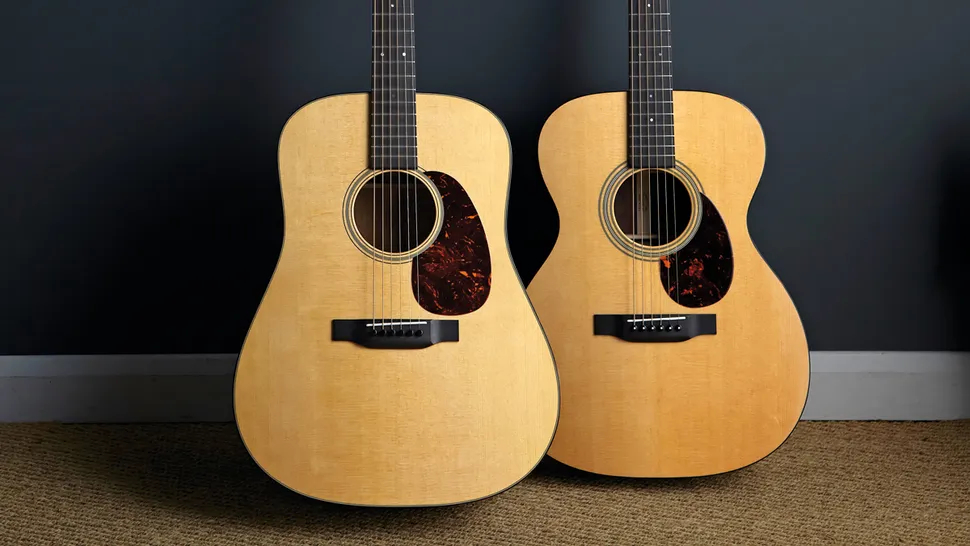
Here at Guitar World, we are experts in our field, with many years of playing and product testing between us. We live and breathe everything guitar related, and we draw on this knowledge and experience of using products in live, recording and rehearsal scenarios when selecting the products for our guides.
When choosing what we believe to be the best acoustic electric guitars available right now, we combine our hands-on experience, user reviews and engage in lengthy discussions with our editorial colleagues to reach a consensus about the top products in any given category.
First and foremost, we are guitar players, and we want other guitarists to find the right product for them. So we take into careful consideration everything from budget to feature set, ease of use and durability to come up with a list of what we can proudly say are the best right now.
Find out more about how we make our recommendations and how we test each of the products in our buyer's guides.
Meet the experts
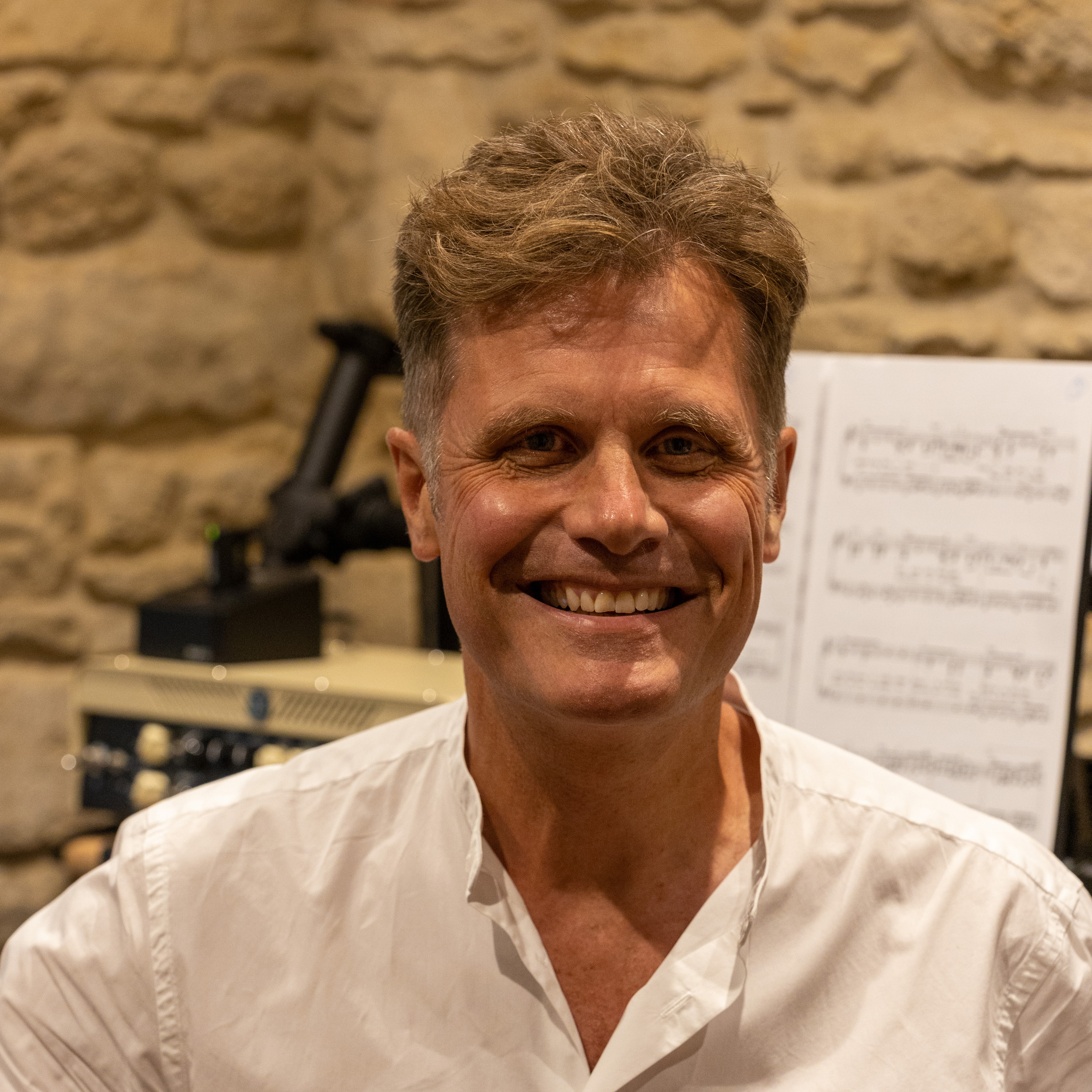
When Simon's childhood classical guitar teacher boasted he 'enjoyed a challenge', the poor man had no idea how much he'd underestimated the scale of the task ahead. Despite Simon's lack of talent, the experience did spark a lifelong passion for music. His classical guitar was discarded for an electric, then a room full of electrics before Simon discovered the joys of keys. Against all odds, Simon somehow managed to blag a career as a fashion journalist, but he's now more suitably employed writing for Guitar World and MusicRadar.

Rob is the Reviews Editor for GuitarWorld.com and MusicRadar guitars, so spends most of his waking hours (and beyond) thinking about and trying the latest gear, while making sure our reviews team is giving you thorough and honest tests of it. He's worked for guitar mags and sites as a writer and editor for nearly 20 years but still winces at the thought of restringing anything with a Floyd Rose.

Connor is a contributor to Guitar World and MusicRadar. Having been a guitarist since the age of 10, he's played bass and guitar in bands across the South West of England. He has a background in audio engineering, having worked in some of the UK’s best studios including Rockfield and Invada, and has a passion for recording guitar. He is always keen to discover the greatest gear for capturing tone, be that microphones, audio interfaces or cab simulators.
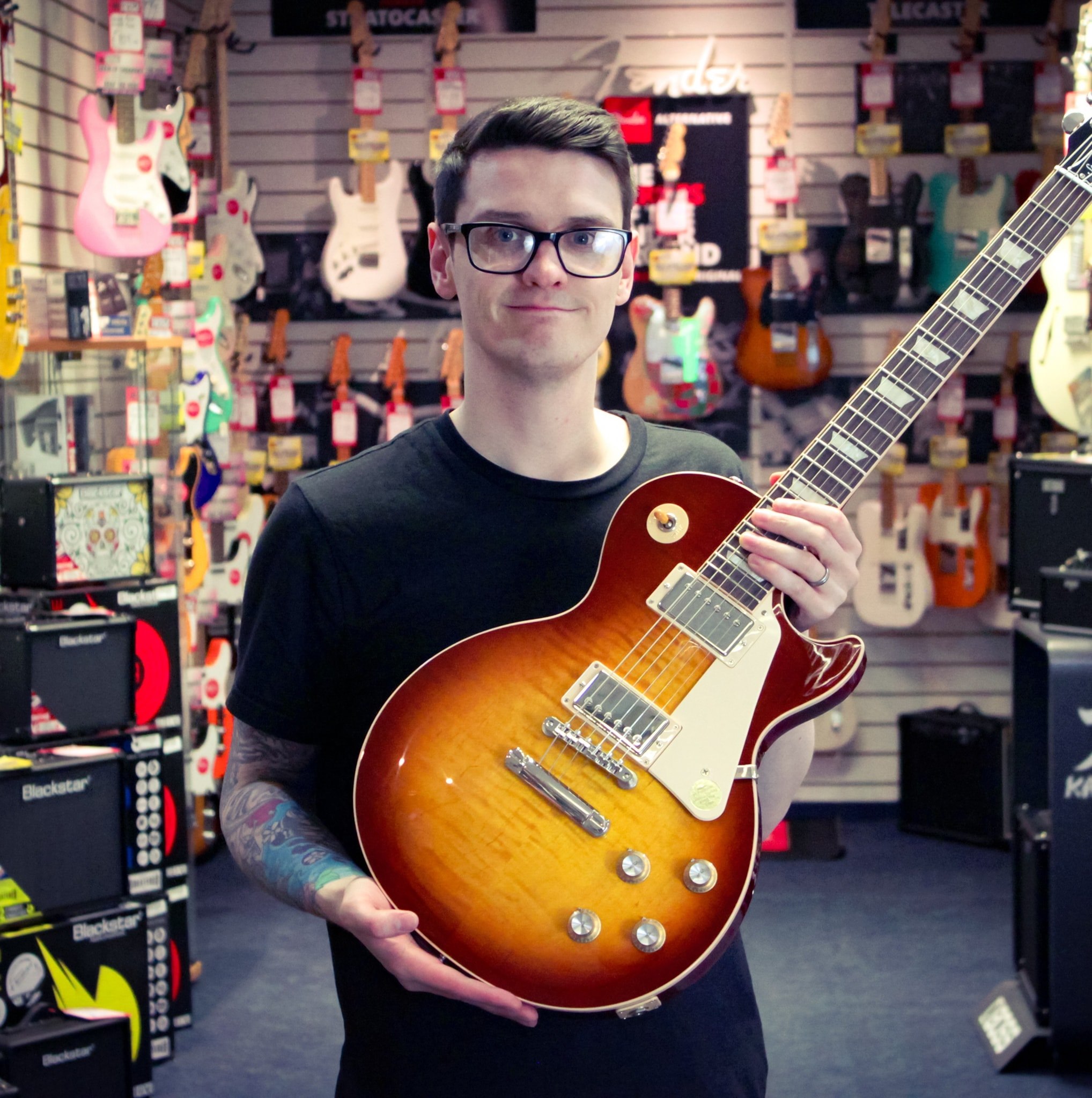
I'm Guitar World's Senior Deals Writer. In this role I create and maintain the 200+ buyer's guides you'll find on the site, find the best deals on guitar products for our readers, and test the latest gear. My reviews have been featured in prominent publications including Total Guitar, Future Music magazine and MusicRadar.com.
During my career, I have been lucky enough to talk to many of my musical heroes, having interviewed Slash and members of The Offspring, Foo Fighters, Sum 41, Thrice, and more. Prior to joining the Guitar World team, I worked in music retail, at Kenney's Music in Dundee, Scotland. For a decade, I advised everyone from absolute beginners to seasoned pros on the ultimate gear for their needs, from beginner acoustic guitars, to top-end modelers.

After spending a decade in music retail, I’m now a freelance writer for Guitar World, MusicRadar, Guitar Player and Reverb, specialising in electric and acoustic guitars, bass, and almost anything else you can make a tune with. When my head’s not buried in the best of modern and vintage gear, I run a small company helping musicians with songwriting, production and performance, and I play bass in an alt-rock band.
Latest updates
27/08/25: The guide has been rewritten from the ground up and now includes a total of eight new products. Each product now has an "at a glance" box along with star ratings. Expert verdict boxes are also now included where applicable. The FAQ section has been completely rewritten and expanded too.
Read more:
You can trust Guitar World
- Best acoustic guitar amps: let your acoustic guitar tone shine
- Downsize with the best 3/4 acoustic guitars
- Explore our pick of the best high-end classical and nylon-string guitars
- Looking to spend as little as possible? Check out the best cheap acoustic guitars
- Up your picking game with the best acoustic guitar picks
All the latest guitar news, interviews, lessons, reviews, deals and more, direct to your inbox!
When Simon's childhood classical guitar teacher boasted he 'enjoyed a challenge', the poor man had no idea how much he'd underestimated the scale of the task ahead. Despite Simon's lack of talent, the experience did spark a lifelong passion for music. His classical guitar was discarded for an electric, then a room full of electrics before Simon discovered the joys of keys. Against all odds, Simon somehow managed to blag a career as a fashion journalist, but he's now more suitably employed writing for Guitar World and MusicRadar. When not writing or playing, he can be found terrifying himself on his mountain bike.
- Rob LaingReviews Editor
- Richard Blenkinsop
- Connor Godfrey
- Daryl RobertsonSenior Deals Writer
